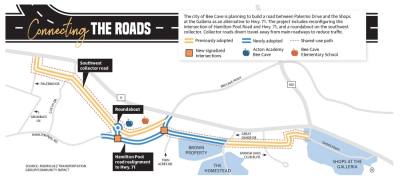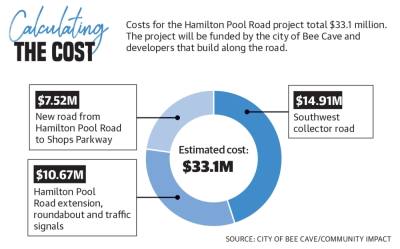Hamilton Pool Road, located just off Hwy. 71 in Bee Cave, will be reconfigured and extended over the next few years to increase connectivity in Bee Cave and reduce reliance on Hwy. 71.
The project is intended to give drivers a safer alternative to Hwy. 71; however, it also raises concerns about safety and congestion for residents whose homes are built near the future extension.
“Don’t make assumptions that this bypass is for Bee Cave locals who are getting to the shops,” Bee Cave resident Niti Madan said. “Thanks to Google Maps, anyone and everyone will be using it to cut across, and we will be seeing a lot more accidents.”
On Feb. 28, Bee Cave City Council will vote to officially add the Hamilton Pool Road extension to the thoroughfare plan, which is a long-range planning tool the city uses to look ahead and identify locations and types of roadways needed to meet growth projections in the future, according to city documents.
The road extension is one of three road segments intended to increase connectivity in the area, combined with a southwest collector road, which diverts traffic from major roads, along Hwy. 71 to the west and an additional road parallel to Hwy. 71 to the east. All three projects total $33.1 million.
The road extension will take three to five years to complete once started, but the timeline for the remainder of the project will depend upon outside developers, Bee Cave City Manager Clint Garza said.
Following the road extension’s adoption, council also has to decide how to prioritize and fund the project, Garza said.
Because the project is in the beginning stages of a feasibility study, which identifies the need and presents it to the public, Garza said there is no set timeline for construction.
“We are dealing with growth pressure,” he said. “[Hwy. 71] is really designed for regional trips. Local jurisdictions [should] build city roads for local trips.”
The Hamilton Pool Road extension that council may approve will cost $10.67 million, said Brock Miller, the project manager for Rodriguez Transportation Group.
Travel times on Hwy. 71 from Palermo Drive to RM 2244, or Bee Caves Road, are projected to improve by 7-10 minutes during peak travel periods when the entire project area is fully built out, Miller said.
In May, the city authorized engineering firm Rodriguez Transportation Group to conduct a study on the feasibility and impacts of a new road connecting Hamilton Pool Road with Bee Caves Road near the Shops at the Galleria.
Council voted to accept the results of the study Jan. 25 and instructed city staff to amend the city’s existing thoroughfare plan to reflect one of the study’s potential road realignment options.
Realigning the road
Rodriguez Transportation Group created multiple roadway options using traffic impact analysis to calculate daily a.m. and p.m. peak travel time totals, according to city documents. Ultimately, the option the engineering firm recommended will connect a proposed southwest collector road to a road that runs through Great Divide Drive, Spanish Oaks Boulevard and Shops Parkway.
This alternative, referred to in the study as Option 2, will realign Hamilton Pool Road beginning near the Acton Academy Bee Cave at 14532 Hamilton Pool Road, Austin, and ending at Hwy. 71.
In addition, the project will include a new roundabout just northwest of Acton Academy Bee Cave and two new signalized intersections that will be installed on Hamilton Pool Road. One intersection will be across the road from the Acton Academy Bee Cave, and the other will be near Twin Acres Drive.
The intersection near Twin Acres Drive will connect Hamilton Pool Road with Great Divide Drive and end at Shops Parkway.
The entire project study area from Palermo Drive to the Shops Parkway is around 3.19 miles in length, Miller said.
Rodriguez Transportation Group studied 11 scenarios in the project area. Miller and his team looked at how each scenario would affect traffic in 2025 and 2040.
“The greatest difference in delay is seen at the intersection of Hwy. 71 and Bee Cave Parkway/Hamilton Pool Road,” he said.
There was over a three-minute time savings for vehicles at this intersection in the full-build scenario, he said.
Mixed resident reactions
Around two-thirds of the comments Rodriguez Transportation received are in favor of the Hamilton Pool Road extension.
Several residents opposed to the project told Community Impact they were concerned about the ability to access their neighborhood as one of the primary reasons for building the road is to divert traffic from Hwy. 71.
Bee Cave Homestead resident Carrell Killebrew said the only exit for the Homestead neighborhood is off Great Divide Drive, and it would be more congested in any type of emergency.
“I think, in the end, the traffic study is going to be misleading,” Killebrew said. “We don’t have any exposure to what the assumptions are in the traffic study.”
Another concern residents raised was the impact to Bee Cave’s green space around the Brown property, a 44-acre parcel of land just off Great Divide Drive.
During the Jan. 25 council meeting, Garza said the city had not conducted an environmental impact study for the project, as that comes later in the construction design process.
One of the benefits cited by Rodriguez Transportation Group for supporting Option 2 is that it is designed to divert traffic away from Bee Cave Elementary School.
Ryan Hahn, a Falconhead resident whose child attends Bee Cave Elementary School, said mobility and safety are huge concerns outside the school. Hahn said he personally witnessed a collision coming out of the school.
“Every time we take a turn out of that school, it is an unnecessary risk,” he said.
Hahn said he is also hoping a road moving traffic away from the school could help with travel times as he only lives 1.9 miles away from Bee Cave Elementary School, and round trips for both pickup and drop-off can take up to 40 minutes, he said.
Ultimately, Hahn said he trusts council to make the right decision for residents in Bee Cave.
“I have learned over the years to trust city leadership and trust they will make the best decision for the most amount of people,” he said.
Next steps
The city has traditionally funded major infrastructure projects through sales tax revenue, given that is where most of the city’s funds come from, Garza said.
Because the land where the Hamilton Pool Road extension and other thoroughfare roads will be built is also on undeveloped property, developers who buy the land will be responsible for funding and building parts of the road, Garza said.
Garza said the city requires development to “pay for itself” through cost sharing with private developers at the time they seek approval for their project from the city. If the thoroughfare plan is approved as presented, these road built by developers will eventually connect, he said.
Bee Cave Mayor Kara King said Jan. 25 she recognized that change is hard.
“Our job is to not have one way for people to get around the city. I firmly believe that,” King said. “There’s not [just] one neighborhood or two neighborhoods taking the brunt of this thoroughfare plan; we’re all taking it.”








